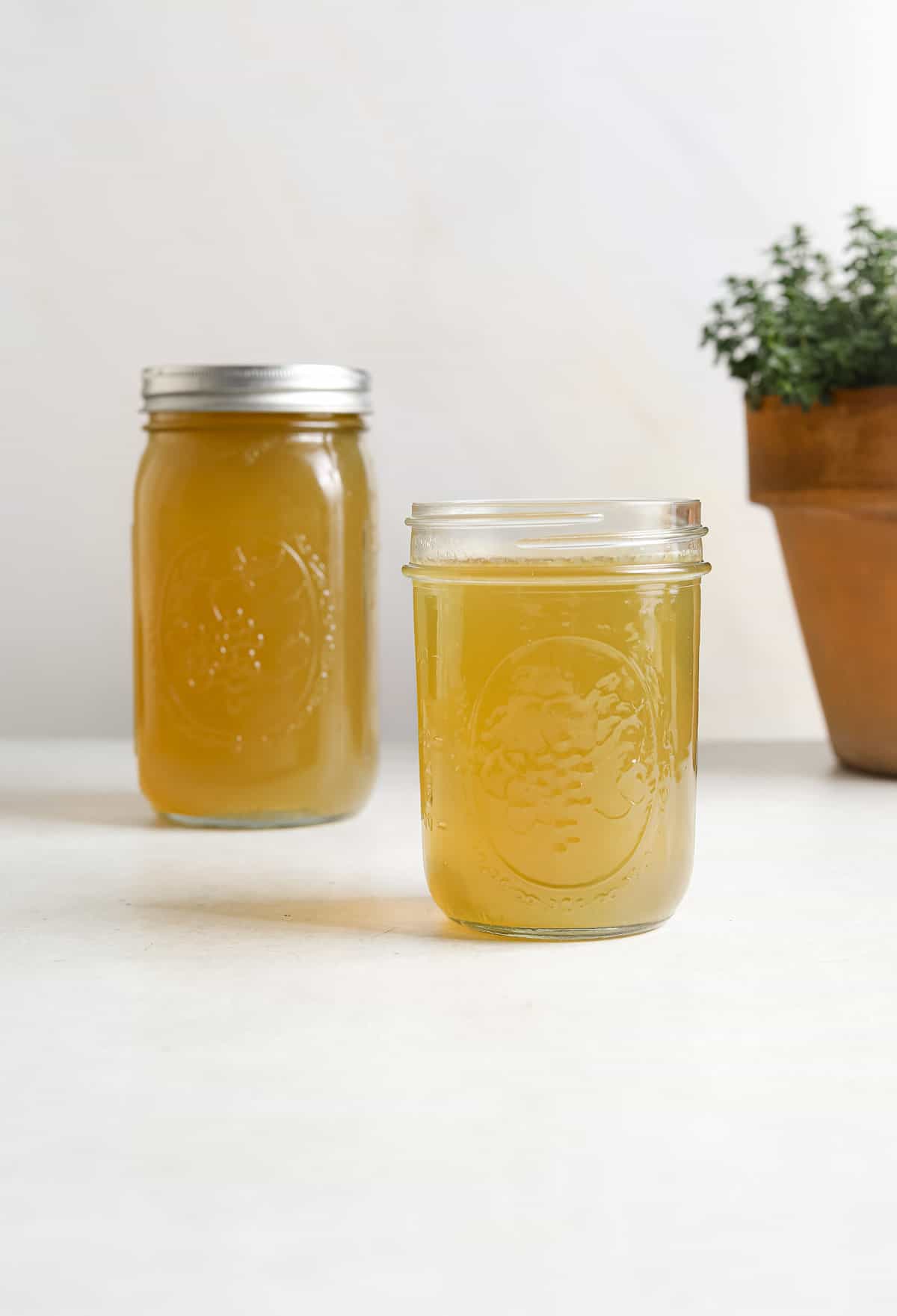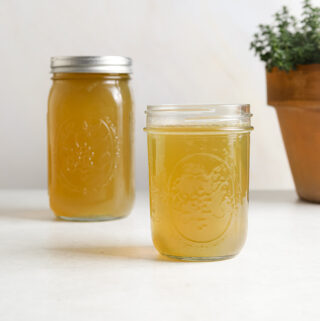Homemade Chicken Stock
Steeped with aromatic herbs, garlic, onion and leeks this versatile (and simple to make) chicken stock is a great way to add depth and flavor to soups, stews and so many other dishes.

Making chicken stock is a fundamental skill for any professional or home cook. It is the foundation for many different recipes, from soups and sauces to stews and braises. A good stock has a deep, rich flavor that can elevate any dish.
This particular recipe is my go-to, everyday chicken stock. It’s a perfect baseline. The slow simmering process allows the flavors of the chicken bones, vegetables and herbs to gently infuse into the stock creating a rich, savory, golden broth.
If you have the time, I highly recommend making your own chicken stock. It’s 1000x better (and better for you) than the store-bought boxed variety. It’s also a great way to use up leftover chicken bones and vegetable scraps. It can be made in large batches, portioned a stored in the freezer for months at a time.
Check out my recipe for: Holiday Turkey Stock.
Ingredients You’ll Need:
To make homemade chicken stock you’ll need; chicken bones, *see FAQs below for specifics* onion, celery, garlic, carrots, leeks, fresh thyme or rosemary, bay leaves and whole black peppercorns.
Scroll to the bottom of the recipe card for ingredient notes and substitutions.

Recipe Step by Step:
Step 1. Bring to a Simmer
Add all of the ingredients to your largest stock pot then fill the pot with water. Place the pot over medium-high heat and bring to a low boil, then turn the heat down to find a nice slow simmer. Note: a low simmer looks like a few small bubbles rising to the surface every few seconds. Little to no movement in the broth itself. Surface is mostly still. Wisps of steam rising from the surface.

Step 2. Simmer and Skim
Skim any foam that rises to the top of the stock. This foam is made up of impurities and will make your stock cloudy. Cover and simmer for a minimum of 4 hours or up to 8 hours.

Step 3. Cool and Store
Strain the stock thoroughly through a fine mesh strainer. Transfer the stock to storage containers to cool.
FAQs and Expert Tips:
The best types of chicken bones for chicken stock are those that are high in collagen and connective tissue. These bones will give your stock a rich, flavorful, viscous broth. Some of the best types of bones for stock include: wings, backs (or carcasses), feet, necks and legs. I usually pick up a variety of wings, legs and feet. If you don’t see these items in your grocery store meat case – ask the butcher. They likely have chicken feet, necks and carcasses available but not on display.
There are several reasons why homemade chicken stock is better than store-bought: freshness, flavor, cost and nutritional value. Because it is made with fresh ingredients that are cooked for a longer period of time, homemade chicken stock has a richer, more complex flavor than store-bought stock. It’s also significantly less expensive to make stock than it is to buy it ready made in cartons or cans. Lastly, the bones in homemade stock release minerals, collagen and nutrients that are not present in store-bought stock.
You sure can! Cool the stock completely then pour it into freezer-safe containers, leaving about 2 inches of headspace at the top to allow for expansion. Seal the container tightly and freeze. If you freeze the stock while it’s still hot, it could break down the proteins and make the stock cloudy. When you’re ready to use the frozen stock, defrost it in the refrigerator overnight.
Tips and Tricks for *The Best* Homemade Chicken Stock:
- Use high-quality chicken bones. The bones should be from a fresh chicken that has been raised in a humane environment.
- Simmer, Never Boil – this phrase sends me straight back to culinary school. The concept was drilled into our heads, and for good reason. Stock should never sit at a rolling boil, but instead a gentle, low simmer. Rapid boiling agitates the rendered fats and proteins creating a cloudy stock. It can also cause the stock to reduce too quickly and become salty.
- Skim any foam that rises to the top of the stock. This foam is made up of impurities and will make your stock cloudy.
- Strain the stock thoroughly through a fine mesh strainer. This will remove any impurities and make your stock clear.

Our Favorite
Recipes Featuring Chicken Stock
I love to hear from readers and always do my best to respond to each and every comment. If you make this recipe be sure to leave a comment and/or give it a rating! Don’t forget to follow along on Pinterest, Facebook, and Instagram for all the latest updates!

Homemade Chicken Stock
Ingredients
- 4 lbs chicken bones or bone-in chicken pieces - wings, legs, feet, necks or carcasses
- 2 whole onions - peeled and quartered
- 2 heads garlic - halved crosswise
- 2 large carrots - peeled and halved
- 2 stalks celery - halved
- 2 leeks - halved lengthwise and rinsed well
- 5 sprigs fresh thyme or rosemary - or 1 tbsp dried
- 1 tbsp whole black peppercorns - or 1 tsp ground pepper
- 2 bay leaves
- 2 tbsp kosher salt
- 6-8 quarts water
Instructions
- Place the chicken bones, onion, garlic, carrots, celery, leek, peppercorns, bay leaves, thyme and salt in a large stockpot. Note: if substituting dried herbs, wait to add them in until the final 30 minutes of cooking.
- Fill the pot with water and bring to a low boil over medium heat. Skim any foam that rises to the top of the stock.
- Reduce the heat to low and simmer, covered for at least 4 hours or up to 8. Check every so often to make sure it's still sitting at a low simmer, skim and discard any foam that rises to the surface. Note: a low simmer looks like a few small bubbles rising to the surface every few seconds. Little to no movement in the broth itself. Surface is mostly still. Wisps of steam rising from the surface.
- Strain the stock through a fine-mesh sieve. Let the stock cool slightly, then ladle into containers and refrigerate or freeze.
Notes
-
- Chicken Bones: The best types of chicken bones for chicken stock are those that are high in collagen and connective tissue. These bones will give your stock a rich, flavorful, viscous broth. Some of the best types of chicken bones for stock include: wings, backs (or carcasses), feet, necks and legs. I usually pick up a variety of wings, legs and feet. If you don’t see these items in your grocery store meat case – ask the butcher. They likely have chicken feet, necks and carcasses available but not on display.
- Fresh vs. Dried Herbs: I prefer the flavor of fresh herbs but in a pinch, dried works too. If you plan to substitute dried herbs, wait to add them in until the final 30 minutes of cooking.
- Chicken Bones: The best types of chicken bones for chicken stock are those that are high in collagen and connective tissue. These bones will give your stock a rich, flavorful, viscous broth. Some of the best types of chicken bones for stock include: wings, backs (or carcasses), feet, necks and legs. I usually pick up a variety of wings, legs and feet. If you don’t see these items in your grocery store meat case – ask the butcher. They likely have chicken feet, necks and carcasses available but not on display.
-
- Storing Chicken Stock: Leftover chicken stock will last for up to 4 days in in the refrigerator, or up to 4 months in the freezer.
- Freezing Instructions: Cool the stock completely then pour it into freezer-safe containers, leaving about 2 inches of headspace at the top to allow for expansion. Seal the container tightly and freeze. If you freeze the stock while it’s still hot, it could break down the proteins and make the stock cloudy. When you’re ready to use the frozen stock, defrost it in the refrigerator overnight.






